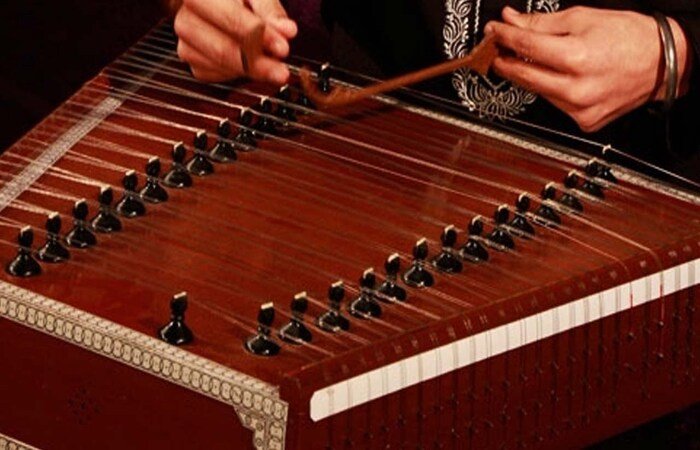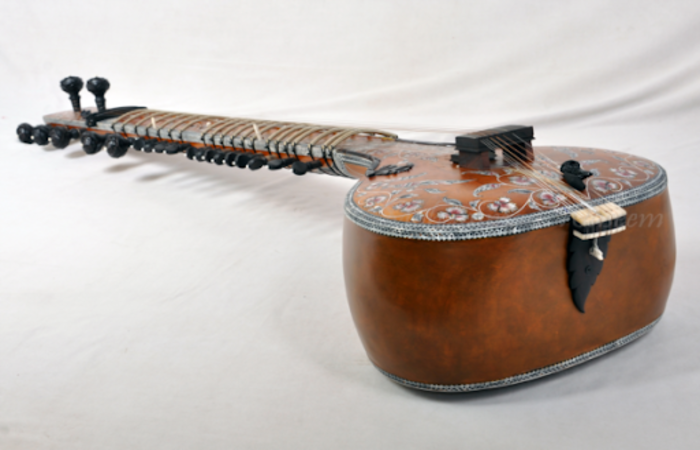A musical instrument is a device designed or modified to produce musical sounds. Musical instruments have existed since the dawn of human culture. Early musical instruments, such as a horn to signal hunting success
A drum in a religious ceremony may have been used for rituals. Cultures eventually developed the ability to compose and perform melodies for entertainment. Kashmiri musical instruments built hundreds of cultures around them.
Jammu and Kashmir has deep musical roots. Kashmiri music embodies the state’s melodic heritage and refined inheritance. In addition, the state has a long history of traditional musical instruments that have become the soul of Kashmiri music.
Kalhana mentioned the history of musical instruments in Kashmir in Rajtarangini, the great poet of Kashmir. So we will discuss some musical instruments of Kashmir below.
Table of Contents
Here are top 6 most popular Kashmiri Musical Instruments:
Let’s take a look at each of them in brief.
Santoor

The Indian santoor is a trapezoid-shaped hammered dulcimer. It is a variant of the Iranian Santur. The instrument is made primarily of walnut and has 25 bridges. Each bridge has four strings, for a total of 100.
It is also a traditional instrument in Jammu and Kashmir that dates back to history. In ancient Sanskrit texts, it was known as Shatha Tantri Veena. The santoor was used to accompany folk music in Kashmir. It is performed in the Sufiana Mausiqi style of music. The trapezoid framework is typically made of walnut or maple wood.
The top and bottom boards are sometimes made of plywood or veneer. Wooden bridges are placed on the top board, also known as the soundboard. This is to accommodate stretched metal strings.
Kashmiri Sitar

Next in our Kashmiri musical instruments list is Sitar. Sitar is a plucked lute with a long neck, similar to the Persian Sitar. According to Curt Sach, the Arabs refer to it as the largest variety. Tanbur Kabir Turki, also known as a large Turkish lute.
The Persian, on the other hand, do not use the word Tunbur. Instead refer to the stringed instrument as Tar. This is why it was commonly referred to as Persian Sitar. This style of Sehtar or Sitar was popular in Kashmir.
Sufiana musicians would use Kashmiri Sitar to accompany this Mousiqui in villages. Unlike the Indian Sitar, which is only used for solo purposes, this musical instrument is specifically designed to accompany Sufian Mousiqui.
Tumbaknari

It is an earthen-shaped instrument used for singing at all Kashmiri functions, particularly weddings. The instrument is thought to have originated in Iran. Tumbaknari is typically played by women at weddings in the valley, and weddings are incomplete without it.
Tumbaknari is also played in Central Asia, but the Tumbaknari used there is made of wood. On the other hand, the Tumbaknari used in Kashmir is made of clay. It is also used to keep time and keep rhythm during a musical performance.
This instrument is known as Tumbakh or Tunbak in Iran. It is known as tumbal or tumbari in the west, and tumbaknaer in Kashmir. The naer is added because the tail end of this instrument resembles a pipe. In Kashmiri it is called a Nore. It has since changed to naer, giving rise to the name tumbaknaer.
Noet
It is the most ancient type of drum variety known to mankind. The shape of the Noet of Kashmir is similar to Ghatam of South India or the Matki of Rajasthan. They are used as instruments in music in those states. Thus indicating that they may have started their journey from the same cultural background.
Their skill and playing style may have differed depending on the traditions prevalent in their respective regions. It is now made of brass or copper, but for musical purposes. Only the earthenware pot is used in Kashmiri music.
It is said that water should never be stored in the Noet used for this purpose. Otherwise, the music will be distorted.
Kashmiri Sarang

The ‘Kashmiri Sarang’ played in Kashmir appears to be an Indian ‘Sarangi.’ This instrument, however, is smaller than the Sarangi. It has a box-shaped body. It has a 10 cm base that is embellished with a frame made by rubbing two pieces together.
There are also seven pegs in the tuner box. In addition, eleven tuners for the resonance strings are attached to the instrument’s side. This instrument is extremely popular among ‘Sufis’. Additionally, this instrument is thought to have been invented by ‘Maharaja Sarang Dev,’ a former ruler of Kashmir.
Raabab

Rabab is an essential component of Kashmiri music culture. It’s made of second-growth mulberry wood. It measures about three and a half feet long. Rabab is usually performed in the form of songs at special occasions and weddings.
It restores the soul’s peace and calm. Rabab is the most enjoyable instrument, and people adore it. Many Kashmiri young artists are hence interested in playing Rabab. Rabab’s main three strings and body are made of goat intestinal skin.
Thus implying that this musical instrument bears the soul of someone, hence the name “Rubab”. The instrument has begun to leave its mark all over the world. It is one of the very popular Kashmiri musical instruments.
Musical instruments have always been the source of peace and cultural diversity. Enjoyed this article? If yes then make sure to like and share this article. Please make sure to tell us which musical instrument is your favorite in the comment section down below.
You may also like Festivals of Kashmir and Kashmiri Folk Songs . We discussed about many festivals in brief in this article which you may like.
NOTE:
List incomplete, not in sequence; information being updated.
